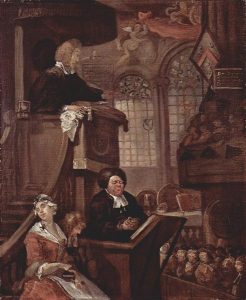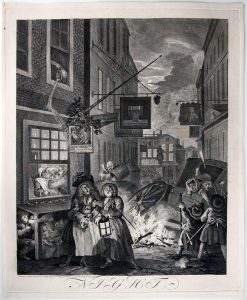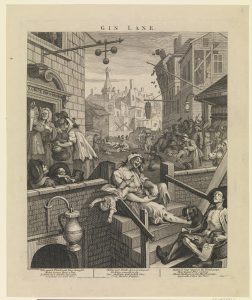Chapter 10: Art of the “Real”
What do you think of these 18th Century prints? Do they exemplify Romanticism?
 |
 |
 |
| Sleeping Congregation. (1736). Engraved Print. | Night. (1738). Engraved Print. | Gin Lane. (1751). Engraved Print. |
William Hogarth was an extraordinarily popular composer of engravings which produced prints that could be sold. The premier Instagram artist of his day, Hogarth used satirical humor to draw attention to social ills like poverty and alcoholism and to moralize about the destructive results of corrupt lifestyles.
Hogarth shared with the Romantics an interest in social castes other than the elite. His snapshots of London life portrayed the wealthy and the poor alike, and his moralizing humor delighted in skewering the idle rich.
Unlike the Romantics, Hogarth was under no illusions about the grand inspiration of the human heart. He delighted his audience by chronicling the wickedness that pervaded London streets. His view of human nature was disillusioned and bleak. He might have claimed that it was realistic.
The late 18th and early 19th Centuries were times of stirring new possibilities in Europe. Science and technology. Industrialized factories that increased trade. Improvements in agriculture. Triumphant colonizing in Africa, the Middle East, India, and China. Europe was wealthy and powerful.
But for everyone who prospered in the new social environment, many more suffered. Landowners dug mines, built factories, and turned peasants off the estates they had farmed for centuries. Skilled textile workers who had always worked in their cottages lost their work to massive machines. The new jobs in mines and factories paid poorly for exhausting, miserable labor. And hundreds of thousands of traditionally well employed peasants found themselves homeless and without work. They drifted to the big cities and lived desperate lives of poverty alleviated with drunkenness. That is, Hogarth’s Gin Lane world.
Realism in art involves choices of subject and technique. But it is above all else an attitude, a disillusioned turning away from cultural myths and ideologies which advocate for the status quo on the basis of promises which “reality” never seems to deliver. Every age produces its realists, but the social upheavals around the turn of the 19th Century led to a level of realistic awareness that has remained into our own day.
References
Hogarth, W. (1751). Gin Lane [Engraved Print]. WikiArt https://www.wikiart.org/en/william-hogarth/gin-lane-1751
Hogarth, W. (1738). Night [Engraved print]. WikiArt https://www.wikiart.org/en/william-hogarth/the-four-times-of-day-night-1736
Hogarth, W. (1736). The Sleeping Congregation [Painting]. WikiArt https://www.wikiart.org/en/william-hogarth/the-sleeping-church-1729
A) a reaction against Neo-Classical Reason that seeks to liberate the individual human imagination and embrace its passions, dreams, and irrational visions as sources of wisdom. B) as an aesthetic, a rejection of strict artistic rules and convention in favor of organic form and innovation. C) often, advocacy for folk traditions that have been despised by classical elites
an attitude of disillusioned skepticism which in art strives to represent reality as it is, questioning cultural myths and ideologies and including uncomfortable subjects that conventional art tends to overlook
